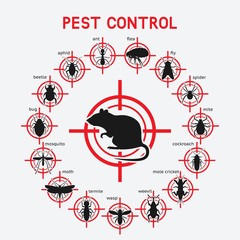The main goals of pest control include the prevention of infestations and the management of pest populations. Pests can be divided into continuous, sporadic, and cyclical. Continuous pests are constantly present, while sporadic pests come and go. Sporadic pests require regular control, while migratory and cyclical pests require intermittent or sporadic control. Finally, potential pests may need control under certain circumstances.

The benefits of pest control are innumerable. Although pest control professionals use safe and natural methods to prevent infestations, it’s still important to hire a professional to care for the problem. Colonial Pest Control can effectively prevent infestations by eliminating the source of their existence. Additionally, they can also use fume-free pesticides to ensure a healthy environment. And by eliminating these sources of infestation, pest-free treatments are a great option for commercial and residential properties.
Determine the scope of the infestation. Some people can tolerate some pests but not others. There may be many pests or pests in a specific location, but they may not be harmful. Learn about the pest in your house and determine whether you can handle its presence without putting the environment at risk. Consider using different methods, including prevention, suppression, and eradication. By following these steps, you can minimize your pest problems and minimize the damage they do.
Biological pest control can be a highly effective way to manage pests. Ladybird beetles and minute pirate bugs are excellent biological controls. Diatomaceous earth is another biological repellent and is often used in combination with plants to deter pests. While chemical pest control is an effective way to get rid of pests, it can also damage fruits and vegetables or pose a threat during fumigation tenting. Aside from pesticides, some organic methods require the use of preservatives to prevent contamination of food.
Environmental monitoring is also an important component of pest control. Monitoring for pests can involve visual inspection, trapping, or scouting. Microbial pests can also be controlled by checking the humidity and temperature in your garden. If there is a noticeable increase in humidity, it may be a sign that you’ve got a pest outbreak. By monitoring these environmental factors, you’ll be able to detect pests and manage them effectively.
Whether pesticides are used for prevention, eradication, or both, proper pest-control methods will help keep your environment safe. Pesticides are made to kill pests, but some can cause harm to humans. The probability of health damage depends on the chemical composition of the pesticide, the type of pest, the amount of exposure, and the time of exposure. Pesticides should be used only by a licensed pest control professional to ensure safety. Avoid using foggers and illegal pesticides. Always read the labels before applying any chemicals to your home.
In addition to traps and other chemical methods, baits are often the first line of defense against pests. Baits are relatively safe and effective but are important to keep out of reach of children and pets. If baits do not work, you can also use other relatively low-risk pesticides. For more effective results, consult your local cooperative extension service office. When using pesticides in areas that are accessible to the public, apply the pesticide only where it is needed. Remember, safety precautions and label instructions always apply to pesticides.
Other insects in the home also pose health risks. Cockroaches, for instance, are common and thrive in warm environments. They also carry various types of bacteria, including those that can cause allergies or respiratory illnesses. Even worse, some of them can cause skin infections and allergic reactions. Bed bugs are parasitic and can easily spread from one place to another. When the infestation gets out of hand, it can affect the entire household. Insects can also damage the home and the property.
Rodents are another category of pests that can be harmful to your business. Mice and rats are two common culprits. They can contaminate crops, gnaw on grain, and even cause electrical fires. Furthermore, rodents can damage crops and cars. Mice and rats can also carry diseases that can affect humans. And pests are no laughing matter! Pest control is essential for preventing these problems and maintaining a healthy environment.
Biological pest control is a method that uses the pest’s natural enemies to keep the population under control. This method relies on the presence of predators and parasites in the area. This approach is not eradication and is often not the best choice if the pests are difficult to control or impossible to eradicate. Biological control also includes sterile males, juvenile hormones, and pheromones. As the population of the pest increases, so do its natural enemies.